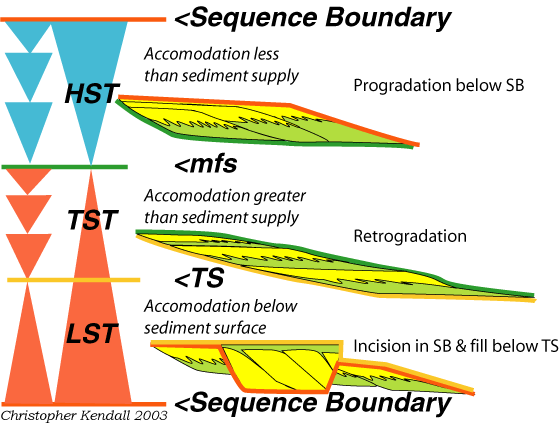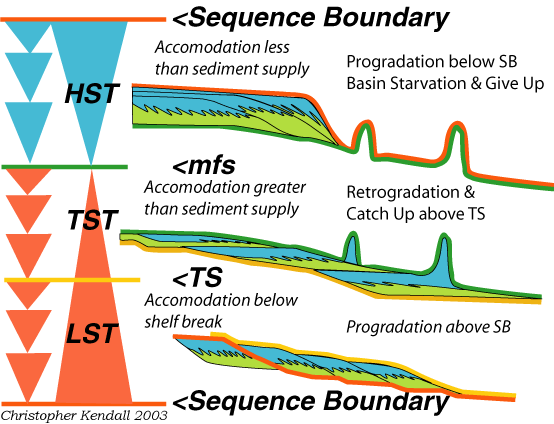|
condensed section
downlap surface
glauconite
glossifungites
hemipelagic sediments
highstand systems tract
pelagic sediments
progradation
transgressive surface
transgressive systems tract
|
A surface of deposition at the time the Shoreline is at its maximum landward position (i.e. the time of maximum transgression) (Posamentier & Allen, 1999)
The surface marks the time of maximum flooding or transgression of the shelf and it separates the transgressive and highstand systems tract. Seismically, it is often expressed as a downlap surface. Marine shelf and basinal sediments associated with this surface are the result of slow rates of deposition by pelagic-hemipelagic sediments and they are usually thin and fine grained. These fine sediments make up the condensed section (Mitchum, 1977).
An mfs is often characterized by the presence of radioactive and often organic rich shales, Glauconite, and hardgrounds. There are commonly widespread thin bedded concentrations of fauna (condensed sections) with high abundaformformnce and diversity. An mfs can often be the only portion of a sedimentary cycle which is rich in fauna. Often in a landward direction the maximum flooding surface may match the underlying trangressive surface formed during or just after the inital transgressive phase that immediately follow sea level lowstands. In this case Glossifungites burrows may occur within this surface. The mfs is not commonly burrowed or bored. Any burrowing or boring are likely connected to the preceding transgressive surface before the water deepens and conditions become inimical for colonization but favour preservation.
The mfs often mark the bounding surface between coarsening and/or fining upward cycles and are used to relate these cycles to deepening and shallowing in the geological section. It is synomous with the maximum transgressive surface (Helland-Hansen and Martinsen, 1996); final transgressive surface (Nummedal et al., 1993) at the top of retrogradational strata, downlapped by highstand normal regressive strata (Catuneanu, 2006).


Ideal clastic Sequence with Incised Valley

Ideal Carbonate Sequence with transgressive build ups
References
Catuneanu,O., 2002, Sequence Stratigraphy of clastic systems: concepts, merits, and pitfalls Journal of African Earth Sciences, Volume 35, Issue 1, Pages 1-43
Catuneanu, Octavian (2006), Principles of Sequence Stratigraphy, Elsevier pp 375
Helland-Hansen, W., Martinsen, O.J., 1996, Shoreline trajectories and Sequences: description of variable depositional-dip scenarios. Journal of Sedimentary Research 66 (4), 670–688.
Mitchum Jr., R. M., (1977), Seismic Stratigraphy and Global Changes of Sea Level: Part 11. Glossary of Terms used in Seismic Stratigraphy: Section 2. Application of Seismic Reflection Configuration to Stratigraphic Interpretation, Memoir 26 Pages 205 - 212.
Nummedal, D., Riley, G.W., Templet, P.L., 1993, High-resolution Sequence architecture: a chronostratigraphic model based on equilibrium profile studies. In: Posamentier, H.W., Summerhayes, C.P., Haq, B.U., Allen, G.P. (Eds.), Sequence Stratigraphy and Facies Associations, vol. 18. International Association of Sedimentologists Special Publication, pp. 55–68.
Posamentier, H.W., Allen, G.P., 1999. Siliciclastic Sequence Stratigraphy: concepts and applications. SEPM Concepts in Sedimentology and Paleontology no. 7, 210 p
|